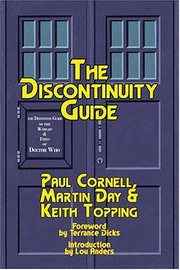Unlike other fictional universes, the Doctor Who universe is created solely by fiction. To us, this is not a valid source. Information from this source can only be used in "behind the scenes" sections, or on pages about real world topics.
The Discontinuity Guide was published in 1995.
Publisher's summary
1st edition publisher's summary
Anorak-Pocket-Sized Edition
Resistance is futile!
Fluffs, goofs, double entendres, fashion victims, technobabble, dialogue disasters; these are just some of the headings under which every story in the Doctor's twenty-seven-year career is analysed.
Despite its humorous tone, The Discontinuity Guide has a serious purpose. Apart from drawing attention to the errors and absurdities that are among the more loveable features of Doctor Who, this reference book provides a complete analysis of the story-by-story creation of the Doctor Who universe.
One sample story, Pyramids of Mars, yields the following gems:
Technobabble: a cytronic particle accelerator, a relative continuum stabiliser, and triobiphysics.
Dialogue Triumphs: "I'm a Time Lord...You don't understand the implications. I'm not a human being. I walk in eternity."
Continuity: the Doctor is about 750 years old at this point, and has apparently aged 300 years since Tomb of the Cybermen. He ages another 200 years between this story and the Seventh Doctor's Time and the Rani.
An absolute must for every Doctor Who fan. Wear your anorak with pride, and keep The Discontinuity Guide in its pocket!
2nd edition publisher's summary

Re-release 2nd Edition Cover
Indispensable, hysterical and brilliant. The Discontinuity Guide is everything the typical television reference manual or episode guide isn't. As well as being a thorough record of every single plot hole, production goof and dialogue blunder and every fascinating tidbit of Doctor Who history and continuity, The Discontinuity Guide is a brilliant attempt to stitch 26 years of television history into a coherent narrative. Well-thought out and credible explanations are offered for the seemingly irreconcilable or merely obscure bits of the mythos, making this an essential reference for the longtime fan and a hilarious introduction for the new one.
Subject matter
A humorous deconstruction of every televised Doctor Who story (up to Survival and including Dimensions in Time).
Notable features
- Each story is broken down and analysed into: Roots (what might have influenced the story), Goofs (mistakes), Technobabble, Dialogue Disasters, Dialogue Triumphs, Continuity, Links, Location, Future History (the Doctor Who vision of Earth post-1995), Untelevised Adventures, The Bottom Line.
- There are boxes inset within the text detailing various aspects including: The Doctor's Family, The First History of the Daleks (following The Daleks), The TARDIS Lock, The Doctor's Ring, Constellations, Dating the segments of time (in relation to the TV story The Ark), Doctor Who? (in relation to WOTAN's proclamation in The War Machines), Cyber History, The Doctor's Doctorate, The History of Mars, Dating the UNIT stories, UNIT call-signs, Season 6b, The location of Gallifrey, Venus, A short history of Atlantis, UNIT's shoot-to-kill policy?, Changing Time (in relation to the SS Bernice and the TV story Carnival of Monsters), Party Politics, Sontarans and Rutans, Earth and time travel, The Second Dalek History (following Genesis of the Daleks), The Doctor's Age, Language (concerning why everyone speaks English), Temporal grace, The Origins of the Time Lords, Shrinking, Aliens and Mankind, The Guardians and the Key to Time, The TARDIS Scanner, Merlin.
Notes
- The first edition featured an introduction by Terrance Dicks while the second edition featured an introduction by Lou Anders, as well as the original introduction.
- The book has spawned similar versions on the internet including:
- The Whoniverse - The Discontinuity Guide which covers all the Virgin New Adventures, Virgin Missing Adventures, BBC Eighth Doctor Adventures, and BBC Past Doctor Adventures, as well as a variety of other prose stories and a number of new series Doctor Who episodes and BBC New Series Adventures.
- Tetrap Discontinuity Guide which covers many of the Big Finish Doctor Who audio stories and some of the audio dramas in the Big Finish - Explored Worlds series'.
- Both sites follow a similar pattern as laid out in the original book.
- The Discontinuity Guide was one of a number of similarly formatted books published by Virgin in the 1990s and early 2000s for various TV shows. Although the Who release focused more on mistakes, other books based upon shows such as The X-Files, Babylon 5 and the Gerry Anderson Supermarionation series were more comprehensive episode guides.
